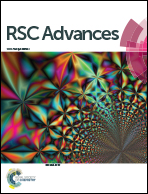Why the thin film form of a photocatalyst is better than the particulate form for direct solar-to-hydrogen conversion: a poor man's approach†
Abstract
We demonstrated an easy method to improve the efficiency of photocatalysts by an order of magnitude by maximizing light absorption and charge carrier diffusion. Degussa titania (P25) and Pd/P25 composite photocatalyst thin films coated over regular glass plates were prepared and evaluated for solar hydrogen production in direct sunlight with aqueous methanol. It is worth noting that only UV light present in direct sunlight (∼4%) was absorbed by the catalysts. The hydrogen production activities of catalysts were compared for thin film and particulate forms at 1 and 25 mg levels. The hydrogen yield values suggested that 1 mg thin film form of Pd/P25 provided 11–12 times higher activity than 25 mg powder form. Comparable light absorption throughout the entire thickness of photocatalyst device and better contact of nanostructures that enabled the charge diffusion and charge utilization at redox sites are the reasons for high efficiency. While solar cells require charge carriers to diffuse through long distances of microns, they are utilized locally in an ensemble of particles (of nanometres) for hydrogen generation in photocatalyst thin films; this concept was used effectively in the present work.



 Please wait while we load your content...
Please wait while we load your content...